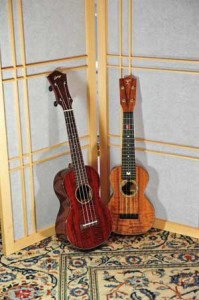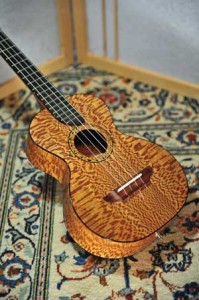 All my friends know that I’ve been a “ukulele nut” for most of my life. A girlfriend in college gave me my first real uke, a mahogany Martin Style 0 that she bought at a thrift store for the whopping sum of one dollar. For years, I carried that uke everywhere, strumming it on backpacking trips in the Sierras, at parties (much to the chagrin of revelers that found the sound only a little less pleasant than an accordion/banjo duet), and when my friends sang on the streets of downtown Santa Cruz for spare change.
All my friends know that I’ve been a “ukulele nut” for most of my life. A girlfriend in college gave me my first real uke, a mahogany Martin Style 0 that she bought at a thrift store for the whopping sum of one dollar. For years, I carried that uke everywhere, strumming it on backpacking trips in the Sierras, at parties (much to the chagrin of revelers that found the sound only a little less pleasant than an accordion/banjo duet), and when my friends sang on the streets of downtown Santa Cruz for spare change.
It was only a few years later that I started collecting ukuleles from pawn dealers, flea markets, old music stores and junky antique shops. Whether made of painted birch ply or the finest solid koa wood, most of my four-string finds were downright cheap to buy in the day when many folks referred to them as toys or children’s guitars. I’m a little embarrassed to tell you how many of these little strummers I’ve accumulated over the years. Let’s just say it’s a good bit more than the total number of routers that Rob Johnstone, Bill Hylton, Chris Marshall and I collectively own.
As the knowledge of my collection has spread though the ukulele universe, I often get calls from musicians and enthusiasts who want to come check it out. One recent visitor was a Mandalyn May, a performer from eastern California (near the gold country), who is both a wonderful singer and uke player. Her quest was to find out how different ukuleles sound, depending on the kind of wood they’re built from. The reason was that a luthier was going to build her a custom instrument, and she didn’t know what kind of wood best suited her. I must admit that I hadn’t really given this subject that much thought, even though I’ve been playing the uke for more than four decades.
The first uke I handed her was a beautiful, concert-sized uke made from sumptuous curly mahogany by Bill Collings in Austin, Texas (at right in the photo above). As Mandalyn strummed this instrument briskly, it sounded loud and clear, yet somehow soft at the same time, with smooth bass tones and a bright midrange. (It also smelled wonderful: like a fancy cigar box made in Cuba). She liked that one OK. The next instrument was also a concert uke, this one an all-koa “Glyph” brand uke (to the left of the Collings in the photo), made some years ago by David Means in Annapolis, Maryland. In contrast to the Collings, the highly figured koa body of the Glyph delivered a warm, yet much punchier, sound, as if the strings responded more quickly to Mandalyn’s deft strumming. Definitely brighter than the mahogany uke, I thought. Interestingly, I think Ms. May responded more directly and intuitively to each instrument’s playability and didn’t immediately feel that one sounded much better than another (of course, these are both top-shelf instruments that even a virtuoso player such as Jake Shimabukuro or James Hill wouldn’t scoff at).
 Then I let her play one of my very favorite ukes: a tenor-sized instrument custom-made for me by a friend and bandmate who just happens to be one of the world’s most renowned luthiers, Rick Turner. This Compass Rose brand ukulele has both a body and a neck fashioned from sycamore wood sawn from a tree that was cut not more than five miles from where I live in the Santa Cruz mountains. Although usually not thought of as a fancy wood, when sycamore is riftsawn, it reveals an intense ray figure that’s about as subtle as a tiger’s striped coat (see the photo at left) . And the sound? Well, after plucking just one chord, Mandalyn smiled the kind of smile that designated that she’d had a “Goldilocks” moment: “This one’s too hard…this one’s too soft…but this one is JUST right!” The sycamore uke sounded bigger and more harmonically complex than the mahogany or koa instruments had (it’s also slightly larger, physically, which accounts for some of the difference). But the Turner tenor also sang in a way that the other two instruments — magnificent as they are — did not. It had a distinct voice that Mandalyn picked up on right away and responded to with glee.
Then I let her play one of my very favorite ukes: a tenor-sized instrument custom-made for me by a friend and bandmate who just happens to be one of the world’s most renowned luthiers, Rick Turner. This Compass Rose brand ukulele has both a body and a neck fashioned from sycamore wood sawn from a tree that was cut not more than five miles from where I live in the Santa Cruz mountains. Although usually not thought of as a fancy wood, when sycamore is riftsawn, it reveals an intense ray figure that’s about as subtle as a tiger’s striped coat (see the photo at left) . And the sound? Well, after plucking just one chord, Mandalyn smiled the kind of smile that designated that she’d had a “Goldilocks” moment: “This one’s too hard…this one’s too soft…but this one is JUST right!” The sycamore uke sounded bigger and more harmonically complex than the mahogany or koa instruments had (it’s also slightly larger, physically, which accounts for some of the difference). But the Turner tenor also sang in a way that the other two instruments — magnificent as they are — did not. It had a distinct voice that Mandalyn picked up on right away and responded to with glee.
The playing session with Mandalyn made me think more about the entire experience of comparing instruments: Is what we hear more about the difference in woods, or is it the difference in the way the instruments are built? Does Turner impart his ukes with a secret kind of Mojo that Collings and Means simply don’t possess? Or is the sound more about the wood, after all? (Stradivarius aficionados have been arguing over these points for eons.) Or, perhaps, the sycamore Compass Rose sings the way it does because the tree it was made from grew in a spectacularly beautiful forest, or because the instrument’s lumber responds to being played so close to where it had grown? OK, the last bit is stretching my sense of rational thought a little too thin for my comfort. But then again, when do musicians exclusively use rational thought when choosing their instruments? You hear them say over and over again that a particular uke or guitar or violin simply “spoke to me.” Who am I to say that it’s the talent of the luthier rather than the voice of the tree that they’re responding to?
Sandor Nagyszalanczy





